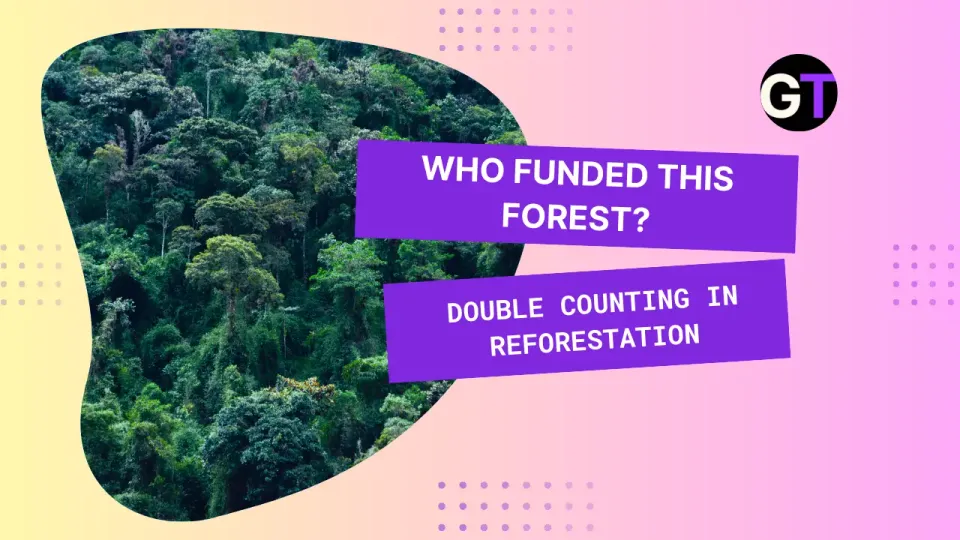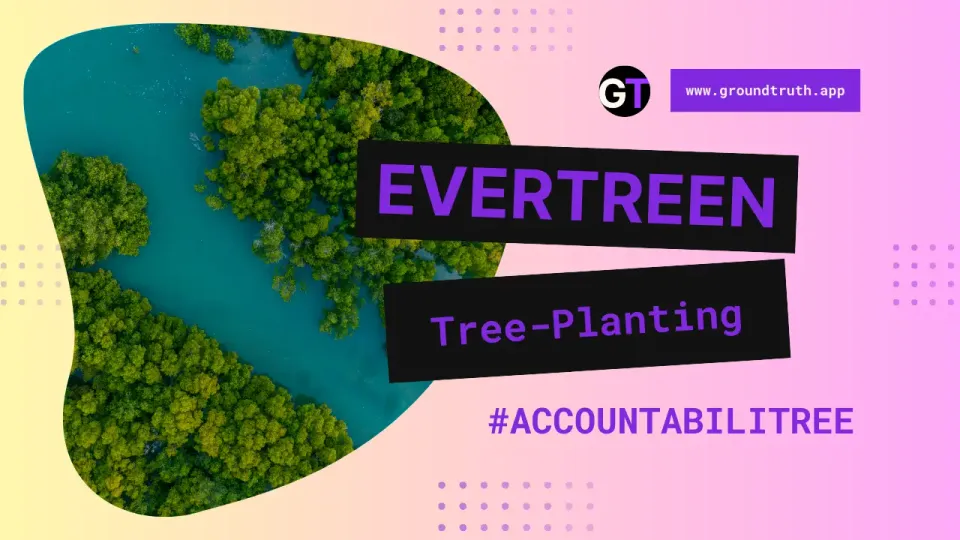Greenland is Getting Greener in Narsarsuaq’s Arboretum
Greenland's greening unites Amaroq Minerals, tree enthusiast Kenneth Høegh, and locals, blending mining and reforestation in Narsarsuaq’s arboretum.
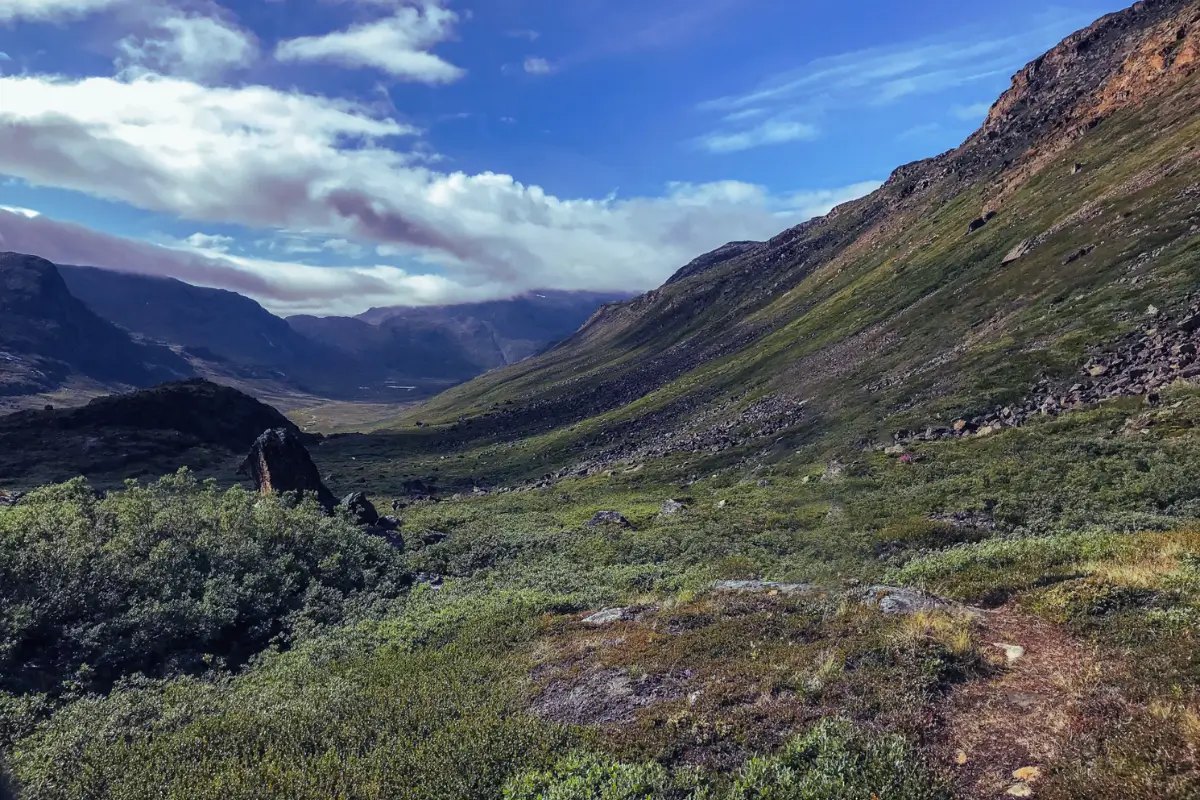
As I walked through passport control in Reykjavik en route to Nuuk, the capital of Greenland, the border agent asked me the standard question of why I was travelling. “To look at trees,” I answered.
He peered at me suspiciously through the glass and said: “There are no trees in Nuuk.”
“Yes there are; people are growing trees there, and there’s a forest in south Greenland.”
“I think you’re lying,” he said flatly, not having any of it. The Icelander seemed to be enjoying this little diversion from the rote reasons most travellers give for visiting Greenland: to see icebergs, Viking ruins, or polar bears.
I was indeed coming to Greenland for the plants – my first visit – and the people who cultivate them. That might sound strange, given that 95% of Greenland, the largest island in the world, is covered by an immense ice sheet. Alarming news about Greenland’s accelerating ice loss (30 million tonnes per hour) appears daily. Less newsworthy, but equally dramatic, is what is happening on the 5% of Greenland’s land that is ice free – it is becoming green.
“Arctic greening” is the climate change phenomenon where land once covered by ice and snow is being colonised by plants. The plants themselves are also changing. Diminutive tundra vegetation is growing taller (so-called “shrubification”) and new plants and insects are moving in from the south.
Across the Circumpolar North (a region spanning three continents that includes eight countries), scientists have observed increases in greening of between 20% and 40% in recent decades. The consensus is that greening is accelerating across diverse Arctic regions.

The Insights section is committed to high-quality longform journalism. Our editors work with academics from many different backgrounds who are tackling a wide range of societal and scientific challenges.
Greening sounds good compared to deforestation, but in the Arctic, the expansion of plant life amplifies dangerous feedback loops. When we think of plants storing carbon from the atmosphere, we typically think of the above-ground plants that we can see. But in the Arctic, carbon storage is mostly below ground, in the frozen soil – permafrost. Permafrost holds more carbon than all the above-ground plants on Earth and twice as much as in the atmosphere.
The growth of trees and shrubs accelerates the thawing of permafrost, increasing global heating in a part of the world that is already warming up to four times faster than the rest of the planet. So, Arctic greening doesn’t just take over land exposed by retreating ice – it probably accelerates ice melt.
But this kind of Arctic greening is not the phenomenon that I came to investigate. I was interested in the deliberate transformation of Greenland into a literally “green land” via new forests, gardens, and farms. This kind of greening began 1,000 years ago with Erik the Red, the Viking who first farmed Greenland’s southern fjords. In one of the earliest real estate boondoggles, Erik named the settlements Greenland (Grœnland in Old Norse) in order to inspire more farmers to follow him to this icy world.
Today, the ancient project of making Greenland green continues in modern, multi-ethnic Greenlandic culture, from mining to gardening to forestry. Intrigued by this convergence of two different kinds of greening – one due to climate change and the other due to human desires – I came to Greenland to understand the connection between them.
So in May 2024 I headed to the Greenland Arboretum in Narsarsuaq, a community of around 100 people near Erik the Red’s farms. The arboretum was established in 2004 but its origins in Nordic forestry go back to the 19th century. Nordic foresters have spent decades planting species from northern Asia, Europe and North America, inspired by scientific curiosity into what can grow, and a colonial assurance that they could decide what should grow.
I have been studying the Arctic for many years, from the controversial legacies of Arctic exploration to my forthcoming book on the Svalbard Global Seed Vault, and I was astonished by what I found. Not only is the deliberate cultivation of new plants happening on a remarkable scale, but there exists a near total absence of laws regulating plants – an approach that appears unique to Greenland. In this legal vacuum, it is not only plants that are flourishing. I learned that Greenland’s plants are thriving because of the entangled efforts of an international mining company, gardening enthusiasts, farmers, and the dedication of a few remarkable men.
I discovered that significant tree planting is funded by a mining company, keen to show its green credentials by “offsetting” its extraction plans. Amaroq Minerals, which holds the most exploration licenses in Greenland, is a key player in the country’s recent critical minerals resource boom. Greenland now rivals China as the planet’s main source for rare minerals essential for green technologies.
Extractive industries that embrace such tree-planting schemes may do so because they are keen to show their green credentials by “offsetting” their extraction plans. Amaroq, however, is keen to point out that it “currently has no plans on accounting for any sequestration on carbon offset”.
Though Amaroq was not involved in the initial set up of the arboretum, by funding tree plantations it is joining Greenland’s 1,000-year experiment in deliberately greening the land. For decades Greenlanders have been working to introduce exotic plants onto their land “to make the city green”, as one gardener told me. It is as if the nation is conducting a large-scale experiment in multiple locations with no controls to see what would happen if the power of plants is unchecked.
Getting lost in the arboretum
The Greenland Arboretum is in Narsarsuaq, a former US base. Today, Hotel Narsarsuaq staff fly Greenland flags out front, reminders of this nation’s autonomy in all matters (except foreign policy and security).
I was here to meet with a Danish biologist, Anders Ræbild, who is conducting research alongside the man largely responsible for the aboretum’s existence, Kenneth Høegh. Høegh is an agronomist and businessman who grew up in Narsaq, a few miles south. He planted his first trees there (Siberian Larch) at the age 14 and he proudly told me they still live today. He now serves as the Greenlandic Ambassador to the US, but in the world of Greenland’s trees, he holds a much more influential position.
This was my first day in Greenland, and even before I reached the arboretum’s treeline, my ears registered the surrealness of this forest in a supposedly treeless land: birdsong was everywhere. Tiny Common Redpolls were careening through the air, feasting on the seeds of the trees. On this sunny, warm day hovering around 0°C, the forest was ringing with their frenzied pursuit of food and sex. The short Arctic summer was just beginning, and all Arctic life, plants included, takes advantage of these few months with abandon.
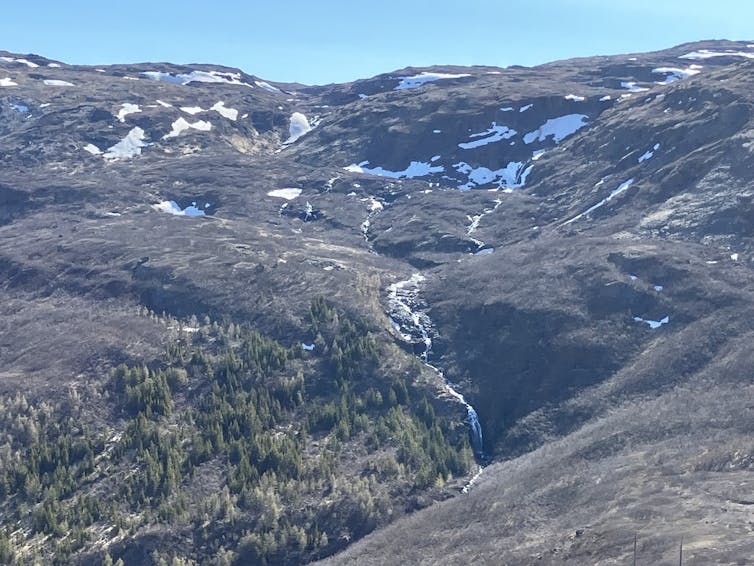
I was travelling with my son River, a university student, and we followed the trees as they climbed up the thin soil of a small mountain peak. Neither arboretum nor forest accurately describes this beautiful place. It is too incoherent to be the former but too ordered to be the latter. Stands of 20 or 30-foot Siberian Larches, Norwegian Spruce, Lodgepole Pines from Colorado, Stone Pines from Mongolia, and the occasional deciduous Alaskan Balsam Poplar were arranged together. This is a meeting place of trees from across the northern world, not a coherent forest from any particular part of it.
It is also remarkably large at nearly 400 acres. So large in fact, that though we were supposed to meet in the forest and could hear one another yelling, we couldn’t find each another within it. I knew the maths in the abstract but I was still overwhelmed by the numbers on the ground – over 100,000 trees planted in all, from over 100 species, since the 1970s.
The man who loved trees
Later that evening, we met Høegh and his colleagues at his cabin for dinner – lamb for them from local farms, cabbage and potatoes for River and me, flown in from Europe like most Greenlandic food.
Høegh is a charismatic man, who was head of the Consultancy Service for Agriculture for the Greenlandic government before he began diplomatic work. After spending several hours in his company, it is clear that regardless of his profession, the trees are his vocation. Høegh described being hand-picked as a student by his predecessor, a Danish forester, along with another forester. The three of them travelled the world for decades, collecting trees. Together these three men appear to have individually directed the planting of the vast majority of trees in Greenland.
At this point, you might be thinking, what about the risks of importing foreign species into an island ecosystem? The potential pests hitching rides in these seedlings? Given that the trees overshadow the tundra plants, what could happen to the local biodiversity given the influx of so many new species? Who is paying for all this? And finally, what are the laws and ethics governing such a large-scale ecological engineering project? These were the questions that brought me to Greenland.
I asked Høegh the question regarding the dangers of importing non-native plants on such a scale. He posed a counter question: when do plants become native? This is a great question, because not just where, but when matters. Plants, like animals, are always on the move and their “native” ranges change over time. We tend to speak of native species in only spatial terms: what is native or non-native to particular places now. When speaking of changes over time, we typically draw the line at what was introduced or eradicated by European colonisation, or humans more broadly.
If people introduce a new plant, this makes it non-native. If animals do it in their fur, feathers, or poop, that is “natural”. The assumption is that humans stand apart from nature, and that nature was in pristine balance before humans (especially Europeans) meddled with it. This Edenic idea is prevalent today, in numerous religious and secular beliefs, including conservation sciences. Regardless of where one stands, the consensus that “native” ecologies are inherently good or easily defined is now highly contested.
Growing a forest
Høegh’s approach to the question of native plants is to take the long view (the extremely long view, in fact) reaching back to Greenland’s ancient forested past. Before the last Ice Age, Greenland was forested with the tree species introduced in the arboretum. Most living things in Greenland migrated there after the ice began retreating 10,000 years ago. All are newcomers, with humans only just behind the pioneer plants, arriving 5,000 years ago.
Høegh suggested that since yews, firs, spruce, and poplar were at home in Greenland long ago, why not now and in the future, when our warming climate is expected to resemble that of the Pliocene epoch, between 2 and 5 million years ago.
When I asked him if he is growing a forest, Høegh said modestly that he sees his work “like a stamp collection”. He is content that the Arboretum can be different things to different people. For him it is a living collection, and for others, it may be a forest or potentially a source of income or even a sacred place.
Waiting for a ferry in Qaqortoq, I heard a rare local voice of dissent. Fredrik, who grew up there, knew many fellow Inuit who had volunteered to help plant the arboretum. Despite that, he said: “I don’t see the meaning of it.” The forest does not move him or interest him, he said, and he has no intention of visiting. Fredrik described seeing alarming ecological changes in the last two years: a new kind of snail plagues his yard in large numbers and he is concerned that the trees are bringing in such pests.
An experiment without controls?
I had asked Høegh about the dangers of importing new plant life, given the potential risks of invasive species. He replied that they always obtain a permit to plant. River, an environmental science student, asked how the trees are altering the soil chemistry and affecting established species. The answer was that no one knows. Greenland’s Arboretum appears to be a large-scale experiment, but I was starting to wonder: where are the controls?
This is where Greenland’s unique political and legal status comes into play. Greenland is one of the few nations that does not recognise international laws against the importation of plants. Laws against the import or export of animals –crucial to hunting and tourism – are very strict. But you can theoretically come into Greenland with any live plant material you like. Once here, there are no clear restrictions on what you can plant in your garden or in open spaces.
I was intrigued by this absence of plant controls. Unlike Denmark, Greenland is not bound by the European and Mediterranean Plant Protection Organization (EPPO) or the International Plant Protection Convention (IPPC). Greenland was exempted from these international treaties governing plant quarantine in 2005.
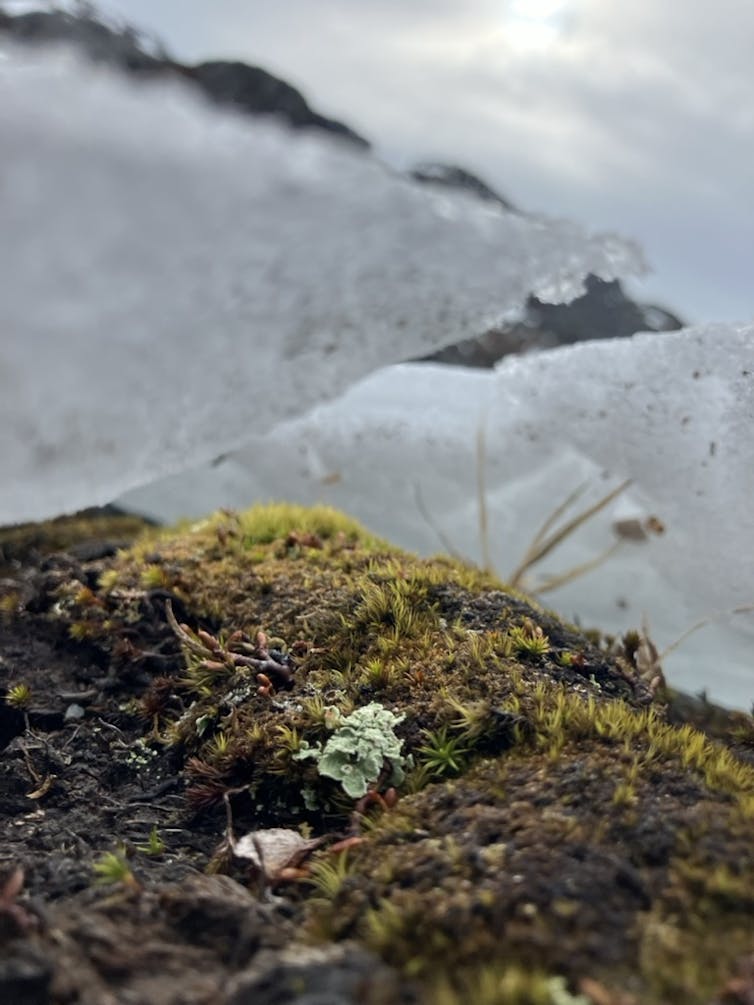
The head of Greenland’s agricultural department confirmed to me that the country “does not currently have legislation regulating plant health”. He also directed me to Greenland’s 2003 “Law on Nature Conservation” which states that the government “can grant permission” and “can set conditions” for foreign plants.
But when I followed up in person at the Qaqortoq municipality office, where permits would be granted, I was told apparently contradictory information: that planting permits are requested and issued verbally, with no paperwork. There are no forbidden species and there is no scientific input. Another administrator confirmed that there weren’t “any standards or rules about what you can bring in or plant”. When I asked him about the local appetite for introducing rules, he said these “would be very hard to administer”. After speaking to many people in Greenland, it does not appear to me (or to many of them) that plant regulations are applied consistently.
Greenland’s exemption from international plant regulations stems from its growing autonomy from Denmark. Colonised by Denmark since 1721, Greenland is a multiracial (Danish and Inuit) and majority-Indigenous autonomous nation moving rapidly toward full independence. After Greenland gained Home Rule in 1979, it pulled out of the European Community (EC) in 1985, and having achieved Self Rule in 2009, it is poised to pursue full independence. Denmark’s participation in European and global plant treaties had meant Greenland too followed those rules. Once Greenland left the EC and colonial status, its plants entered a legal limbo.
Greenland’s trajectory towards full independence is entwined with its booming extractive industries. Full independence would mean the end of the Danish block grant of DKK 3.9 billion (just over £435 million) that provides about half of Greenland’s public budget.
The question now is how Greenland will self-fund its future. After several reversals of policy on uranium and oil exploration, in 2021 a new Indigenous-majority Greenlandic government committed to extracting rare earth elements and minerals for a fossil fuel-free future.
While all eyes have thus focused on Greenland’s extractive potential, plants have slipped through the cracks. But my research has uncovered a previously unknown connection between the two.
Mining, greening and offsetting
Significant tree plantings are currently funded by Amaroq Minerals, which is opening a new gold mine in South Greenland. Registered in Canada, Amaroq is part of a new generation of mining companies extracting the rare earth minerals needed for the wind turbine magnets and car batteries crucial to the green energy transition.
I discovered this link between the trees and mining when I visited the Upernaviarsuk Research Station farm to learn how agriculture is coping with the destabilising climate. I was surprised to see thousands of tree seedlings growing in their vegetable greenhouses. Farm director Kim Neider told me the trees were funded by Amaroq and destined for the arboretum.
In subsequent conversations with Amaroq’s leadership, I learned that they have been active in funding Greenlandic tree plantations for several years, and that 2023 was the first year in which they actually produced seedlings, for Qanasiassat, another plantation that Høegh is expanding near the arboretum. In 2023, Amaroq funded the cultivation of 14,500 seedlings, committing DKK 348,500 (worth about £38,740 today). They have agreed to a further $2,000 Canadian dollars per year going forward, although the company has said there is not a limit on this figure.
Amaroq has a social vision almost as ambitious as its extractive vision, fuelled by its extensive exploration licenses and gold mine opening in Nalunaq, South Greenland, in 2024. Using the profits from this mine, its young CEO, Eldur Olafsson, explained to me, they intend to become a “climate company”, helping to build a sustainable hydroelectric power grid (currently, most smaller communities run on diesel).
Funding tree planting could give Amaroq carbon credits, which many companies purchase to offset their high carbon emissions – this approach has been criticised by many as a form of greenwashing. Amaroq says it “currently” has no plans to do so – “perhaps in the future,” I was told.
But primarily the plantings are a part of their social vision to benefit local livelihoods (like forestry) in the future, Olafsson wrote in an email to me. If this sounds like Høegh’s vision for the arboretum, that is because he arranged the funding partnership with Amaroq and calculated their carbon offset, according to Amaroq’s executive vice president who confirmed this to me over Zoom and email, sharing the carbon calculation with me. Amaroq later told me this was an “informal calculation”.
Granting any carbon offset credit for tree planting in the Arctic is controversial because it generates more greenhouse gases than the trees can capture. One quarter of the northern hemisphere is permafrost, a frozen accumulation of thousands of years of dead plants (and pathogens) storing vast amounts of carbon. The tree roots deepen the active layer of the permafrost (the thin layer of soil that thaws and refreezes each year). They introduce microbial activity into the frozen soil, accelerating the permafrost thaw and allowing for decomposition (and carbon release) to continue through the winter. Scientists describe the smell of thawing permafrost as anything from a “pooey vinaigrette” to a “peaty Scotch”. Also, the taller the plants, the more they absorb the sun’s energy instead of reflecting it like the snow beneath them would.
Greenland’s trees are also capturing carbon dioxide. But because trees grow more slowly in the Arctic than elsewhere, it will take decades before any carbon benefit can balance the carbon they release now. And even at the global scale, in 2023 scientists were alarmed to discover that the “carbon sink” (the plants) we rely on to absorb our carbon emissions failed to absorb a net amount of carbon for the first time ever.
Greenland is pursuing independence and extraction simultaneously in this volatile new climate. Amaroq’s involvement with tree planting in Greenland shows that plants are present in both pursuits.
I believe Greenland’s laissez-faire attitude to plants is directly related to its move towards independence. It is not an oversight, but a reaction against the policy of isolation that Danish colonisation imposed for so long. For two centuries, Denmark controlled Greenland’s contact with the outside world: movement of people, plants, animals and goods to or from Greenland required Danish government permission. This economic and cultural paternalism that Greenlanders endured helps explain their libertarian attitude to plants today. Greenland can at last choose its own laws, and its own plants.
‘We always wanted to live in a forest’
But Amaroq and the arboretum are not acting alone and are relative newcomers compared to the established efforts of farmers and gardeners when it comes to greening the land. As I visited farms and gardens, I was surprised by the passion of Greenlanders for their plants. But my surprise was due to my own assumptions of what Greenlanders should care about.
When I visited the garden of one Qaqortoq gardener, Alibak Hard, I understood the inadequacy of these assumptions. He told me stories about his individual plants, including Greenland’s only maple tree (planted by Høegh) and even a pansy, flowering at my feet in freezing temperatures. I asked Alibak about the source of his passion for exotic plants and he said: “We always wanted to live in a forest.”
You can be born and live your life in this Arctic land dominated by ice and yet dream of alien plantscapes – forests full of red-leaved maples, strange flowers underfoot. I told Alibak that many of my fellow academics would say bringing foreign plants into Greenland reflects a colonial, not a Greenlandic, attitude to nature. He replied: “Why shouldn’t we change the land like we want?”
Another Qaqortoq gardener told me about the garden club he began in the 1980s, which had over 100 members who would collectively import new plants from Iceland every year. Their goal, he said, was “to make the city green”.
When Greenlanders assert such a desire to shape their lands, to diversify the plants in their daily lives, it runs counter to outsider ideals of what Greenland should be. Greenland has been imagined as a sublime icescape onto which outsiders projected their desires – for primordial nature, or authentic Inuit culture unspoiled by modernity. Listening to Greenlanders’ views on plants challenged my expectations of what resistance to colonialism looks like. Transforming your lands and plants as you wish can be a powerful exercise of independence.
Ultimately, no one knows how the introduction of hundreds of new species via gardens, farms, and tree plantations is affecting Greenland’s ecology now that the warming climate enables these plants to thrive. I collected many anecdotes about ecological novelties – red beetles never seen before, new birds, new snails, an outbreak of caterpillars. The most obvious newcomer required no one to alert me, because this purple plant was everywhere I walked in Qaqortoq: Nootka lupines.
This Alaskan plant was introduced multiple times in Greenland because it can enrich soil by fixing nitrogen and can combat erosion. Gardeners also introduced them for their beauty. Once established, though, Lupines can rapidly become invasive.
Icelandic conservationists recruited lupines in the 1970s to reverse soil erosion, but today those ecosystem engineers have expanded their range by a shocking 35-fold. There is now open biological warfare between locals and lupines in eastern Iceland. Arctic greening appears purple on the eastern slopes of Iceland, and south Greenland may be heading in the same direction.
Without clear laws on which plants cannot be introduced, there is theoretically nothing to stop someone also experimenting with Giant Siberian Knotweed or gorse. Such pioneer plants are brilliant at thriving in disturbed environments and can help establish a succession of new life, even as they decrease biodiversity by crowding out established plants.
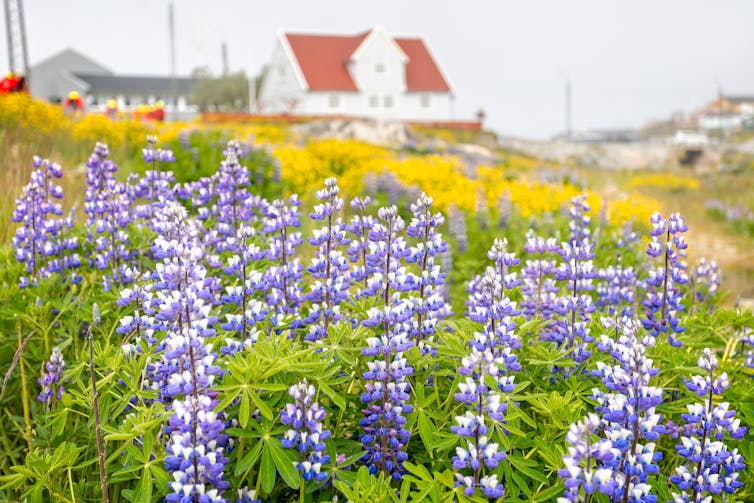
Stefano Mancuso is a biologist fascinated by invasive plants because of their remarkable survival skills, which he believes are signs of their intelligence. “The invasive species of today,” he writes, “are the native flora of the future, just as the invasive species of the past are a fundamental part of our ecosystem today.”
I share the long view with Høegh and Mancuso, that “native” species need to be rethought in both space and time, given the dynamic movements of plants in their 400+ million years evolving on Earth. But in the short term in Greenland, I worry that living solely with this long view without safeguards on moving plants in the present is dangerous.
And this assumption that it is okay for a few men to initiate the transformation of hundreds of acres of communally-owned land is a cavalier one. It resembles the colonial-era attitude that Greenland is a site suitable for social or environmental engineering.
Is it possible to hold these different timescales in mind simultaneously, to act both with short and long-term perspectives? I say yes, it is both possible and necessary to do this. Before releasing thousands of plants onto Greenland’s tundra because they can grow there, or they used to grow there, there should be public consultation, considering whether they should grow there today.
Høegh and his affiliates like Greenland Trees (which accepts international donations to plant trees for carbon offsets) engage local schools to help plant the trees, but it is unclear if ecological education plays a role. Amaroq likewise partners with Siu-Tsiu, the state programme helping young Greenlanders develop new jobs. This may be admirable social engagement, but it follows the lead of select individuals or external groups to green Greenland, rather than a collective desire to do so.
Future warming
Greenland had little to fear from pests, wildfires and invasive species in the past due to its cold climate. But today, the risk perception of these hazards lags behind the new warming climate. And Greenland’s laws governing plants also lag behind the new climate.
But the embrace of tree planting, cosmopolitan gardening, and farming by many Greenlanders also reflects their extraordinary ability to innovate. Greenlanders are not just skilled at adapting to change, argues anthropologist Mark Nuttall, but at anticipating change proactively.
Extraction and greening are rapidly co-evolving in Greenland, following the expanding networks of mines, roads, military bases, farms and airports. The trees planted by Høegh and Amaroq reveal their seamless integration. I asked scientists if they could foresee what these new forests might look like in 50 or 100 years. They agreed that the situation was too complex to predict.
Yet the scientific consensus holds that “future warming is likely to allow growth of trees and shrubs across much of ice-free Greenland by year 2100,” including its far north. The question remains then: will people, from gardeners and farmers to mining corporations, aid more plants in reaching these warming lands, despite the risks?
Greenlanders speak with many voices on questions of what to extract and how, and which plants to grow and where. In this modern society, climate change intensifies the importance of paying attention to the plants in the present, literally and legally. To see the plants in the foreground of a changing Greenland is to perceive the dramatic changes they too are creating at breathtaking speed.

For you: more from our Insights series:
To hear about new Insights articles, join the hundreds of thousands of people who value The Conversation’s evidence-based news. Subscribe to our newsletter.
Adriana Craciun, Institute Associate at the Scott Polar Research Institute, University of Cambridge, and Emma MacLachlan Metcalf Chair of Humanities, Boston University
This article is republished from The Conversation under a Creative Commons license. Read the original article.



